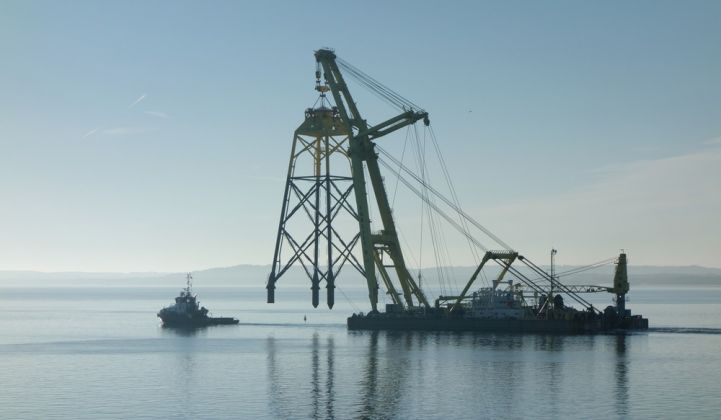Momentum is growing for U.S. offshore wind, and expectations for China are sky-high. But Europe is where the real market action is happening today, as a flurry of recent news highlights.
Last week, Swedish developer Vattenfall won a Dutch government tender with a zero-subsidy bid in the latest big European offshore wind announcement.
Vattenfall said its Hollandse Kust Zuid (HKZ) 3 and 4 projects, with a combined capacity of around 1.5 gigawatts, would benefit from synergies from two previous plants, HKZ 1 and 2, which will be the first zero-subsidy offshore wind farms in the world once commissioned off the Netherlands.
Vattenfall’s win in Holland’s second offshore wind tender comes less than a month after auction results in nearby France prompted lawmakers to increase capacity allocations.
The French government said it would tender a gigawatt of offshore capacity per year through 2028, following a tender that saw a consortium of EDF Renouvelables, innogy and Enbridge bidding 44 euros ($50) per megawatt-hour to win 600 megawatts of capacity off the coast of Dunkirk.
At the same time, the European policy newswire Euractiv reported that German officials were debating whether to lift the country’s 2030 offshore wind capacity target from 15 gigawatts to 20 gigawatts as a way of compensating for sluggish onshore market growth.
Karin Ohlenforst, director of market intelligence at the Global Wind Energy Council, said it is notable that so many European countries are pressing ahead with offshore wind plans at the same time.
“The high number of announcements is actually what counts here,” she said, more than any individual project or award.
Cost reductions driving policy expansions
The Dutch and French announcements, in particular, illustrate the extent to which the European offshore wind industry has reduced its costs.
Holland’s zero-subsidy projects are an extreme case and one that might be difficult to replicate in other countries, said Giles Dickson, the CEO of the European wind energy association WindEurope, in a press release.
“The ‘zero bid’ system seems to work in the Netherlands because the Dutch share a lot of the project risk and it’s not hard for wind farms to find corporate buyers for the power they produce,” he noted.
Most other countries will still need to offer stable revenue streams for projects to get built. But in that context, a price of $50 per megawatt-hour in France is remarkable — and a turning point for French offshore wind, which has been blighted by delays after initial tenders held in 2012 and 2014.
One of the reasons the almost 1.5 gigawatts of capacity awarded in those earlier French rounds has not been built is cost.
Last year, the French government decided that the €200 ($225) per megawatt-hour it had promised to developer Eolien Maritime France (EMF) was far too much given the reductions in offshore wind costs seen in other markets.
EMF saw its price slashed to €150 ($169) per megawatt-hour, but even at that level there was a danger offshore wind could be seen as an expensive pursuit in France. The Dunkirk tender outcome has helped demonstrate the technology is now cost-effective.
“This was a very important announcement for the French offshore market,” said Ohlenforst. “These €44 per megawatt-hour bids sent a positive signal, and we saw that also with the followup announcement from the French government.”
China on the rise
The intense activity seen in European offshore wind markets is acting as a draw for investors.
Last month, for example, London, U.K.-based Glenmont Partners announced it would be investing in offshore wind for the first time after raising €850 million ($958 million) for its third clean energy fund.
Despite this, Europe’s wind industry as a whole is in decline as a result of permitting challenges and under-subscriptions in onshore tenders across France and Germany. This month, Wood Mackenzie downgraded its European wind outlook by 2.2 gigawatts.
And even while offshore wind in Europe maintains healthy growth, it won’t be enough to stop the continent from losing out to Asia over the next decade, according to the Global Wind Energy Council’s forecasts.
By 2030, said Ohlenforst, Europe is expected to have a total of 80 gigawatts of offshore wind capacity. But Asia will have hit 100 gigawatts, mainly on the back of galloping installation rates in China.




